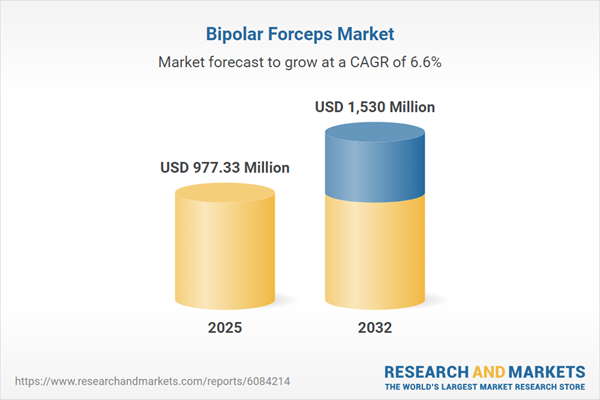Speak directly to the analyst to clarify any post sales queries you may have.
Bipolar forceps are shaping the future of modern surgical environments, with advancements in design and workflow integration driving increased adoption. This market research delivers actionable insights for senior healthcare decision-makers navigating an evolving electrosurgical devices landscape.
Market Snapshot: Bipolar Forceps Market Growth Overview
The bipolar forceps market registered robust expansion, rising from USD 915.82 million in 2024 to USD 977.33 million in 2025. The sector is forecast to grow at a CAGR of 6.63%, attaining USD 1.53 billion by 2032. This momentum reflects escalating demand for precise, efficient surgical devices suited to a wide spectrum of specialties including general, gynecological, cardiovascular, neurosurgical, and urological procedures. Factors such as procedural safety, integration with energy platforms, and minimization of collateral tissue effects are central to current procurement and development trends. Senior decision-makers must track these patterns as they affect capital allocation and device strategy across global health systems.
Scope & Segmentation
- Type: Disposable instruments; Reusable instruments
- Distribution Channel: Direct Sales; Distributors
- End User: Ambulatory Surgical Centers; Clinics; Hospitals (including Government Hospitals and Private Hospitals)
- Application: Cardiovascular Surgery; General Surgery (further classified into Laparoscopic and Open procedures); Gynecological Surgery; Neurosurgery; Urological Surgery
- Regions: Americas, Europe, Middle East & Africa, Asia-Pacific, with representation in countries including the United States, Canada, Brazil, United Kingdom, Germany, France, China, India, Japan, Australia, and others
- Companies Covered: Medtronic plc, Johnson & Johnson, B. Braun Melsungen AG, Olympus Corporation, Stryker Corporation, CONMED Corporation, KARL STORZ SE & Co. KG, Richard Wolf GmbH, Teleflex Incorporated, Smith & Nephew plc
This broad scope supports detailed trend analysis and strategic benchmarking, spanning technology adoption and procurement patterns in clinical and regional segments.
Key Takeaways for Senior Decision-Makers
- Demand for bipolar forceps is driven by the shift to minimally invasive procedures, with hospitals investing in instruments that improve operating room efficiency and reduce surgical risk.
- Clinician preference is increasing for devices that combine precision, reduced instrument exchange, and integration with advanced energy systems, supporting both open and laparoscopic approaches.
- Procurement logic now emphasizes lifecycle cost, infection control, and compatibility with hospital sterilization processes, raising the bar for both disposable and reusable product variants.
- Regional regulatory requirements and procurement cultures shape adoption, with Americas and Asia-Pacific presenting distinct opportunities for platform deployment and service growth.
- Competitive landscapes are fragmented, with leading manufacturers leveraging clinical partnerships, supply reliability, and differentiated service offerings to achieve strategic advantage.
- Sustainability mandates and supply chain resilience are emerging as critical factors for long-term procurement and product success in operating environments worldwide.
Tariff Impact: Navigating Policy and Supply Dynamics
Tariff adjustments enacted in 2025 have altered sourcing strategies and raised import costs, compelling manufacturers to reevaluate supplier relationships and pursue local assembly or nearshoring. Pricing transparency has become essential, as procurement teams increasingly require clear breakdowns of cost drivers and look for suppliers able to demonstrate agility in absorbing regulatory or logistical fluctuations. Hospitals and clinics now prioritize supply continuity alongside contract value, driving new benchmarks for supplier selection and inventory management.
Methodology & Data Sources
This research applies a multi-method approach, synthesizing primary interviews with surgeons, device engineers, and procurement managers alongside analysis of regulatory filings, peer-reviewed literature, supplier disclosures, patent registrations, and clinical registries. Cross-validation, scenario assessment, and expert review panels ensure that the findings are robust, actionable, and anchored in real operating room and procurement realities.
Why This Report Matters
- Equips strategic leaders with credible, segmented insights into technology adoption, regional dynamics, and procurement imperatives for the bipolar forceps market.
- Supports informed capital and supply decisions, assisting health system executives and device manufacturers in aligning portfolios with evolving clinical and operational needs.
Conclusion
The evolution of bipolar forceps reflects interconnected advancements across clinical practice, technology integration, supply logistics, and procurement strategy. Organizations that embrace localized, evidence-based innovation and resilient supply partnerships will be best positioned to enhance surgical safety, efficiency, and operational sustainability.
Table of Contents
3. Executive Summary
4. Market Overview
7. Cumulative Impact of Artificial Intelligence 2025
Companies Mentioned
The companies profiled in this Bipolar Forceps market report include:- Medtronic plc
- Johnson & Johnson
- B. Braun Melsungen AG
- Olympus Corporation
- Stryker Corporation
- CONMED Corporation
- KARL STORZ SE & Co. KG
- Richard Wolf GmbH
- Teleflex Incorporated
- Smith & Nephew plc
Table Information
| Report Attribute | Details |
|---|---|
| No. of Pages | 199 |
| Published | October 2025 |
| Forecast Period | 2025 - 2032 |
| Estimated Market Value ( USD | $ 977.33 Million |
| Forecasted Market Value ( USD | $ 1530 Million |
| Compound Annual Growth Rate | 6.6% |
| Regions Covered | Global |
| No. of Companies Mentioned | 11 |









